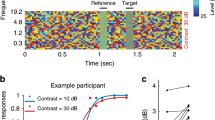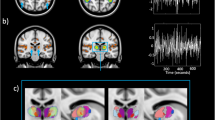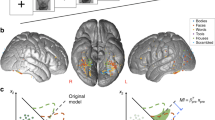Abstract
Neuronal responses to visual stimuli depend on both the nature of the stimulus and brain state. Here we examined the contrast sensitivity of visual thalamic neurons as awake rabbits shifted between alert and nonalert states. We found that despite a large increase in response gain with alertness, contrast sensitivity remained nearly constant. This accurate scaling might be achieved through a balanced increase in excitation and inhibition with alertness.
This is a preview of subscription content, access via your institution
Access options
Subscribe to this journal
Receive 12 print issues and online access
$209.00 per year
only $17.42 per issue
Buy this article
- Purchase on Springer Link
- Instant access to full article PDF
Prices may be subject to local taxes which are calculated during checkout


Similar content being viewed by others
References
Bezdudnaya, T. et al. Neuron 49, 421–432 (2006).
Swadlow, H.A. & Weyand, T.G. J. Neurophysiol. 54, 168–183 (1985).
Solomon, S.G., Peirce, J.W., Dhruv, N.T. & Lennie, P. Neuron 42, 155–162 (2004).
Sclar, G., Maunsell, J.H. & Lennie, P. Vision Res. 30, 1–10 (1990).
Chance, F.S., Abbott, L.F. & Reyes, A.D. Neuron 35, 773–782 (2002).
Murphy, B.K. & Miller, K.D. J. Neurosci. 23, 10040–10051 (2003).
Li, B., Funke, K., Worgotter, F. & Eysel, U.T. J. Physiol. (Lond.) 514, 857–874 (1999).
Weyand, T.G., Boudreaux, M. & Guido, W. J. Neurophysiol. 85, 1107–1118 (2001).
Castro-Alamancos, M.A. J. Physiol. (Lond.) 539, 567–578 (2002).
Shapley, R.M. & Victor, J.D. J. Physiol. (Lond.) 318, 161–179 (1981).
Bonin, V., Mante, V. & Carandini, M. J. Neurosci. 25, 10844–10856 (2005).
Przybyszewski, A.W., Gaska, J.P., Foote, W. & Pollen, D.A. Vis. Neurosci. 17, 485–494 (2000).
Williford, T. & Maunsell, J.H. J. Neurophysiol. 96, 40–54 (2006).
Martinez-Trujillo, J. & Treue, S. Neuron 35, 365–370 (2002).
Reynolds, J.H., Pasternak, T. & Desimone, R. Neuron 26, 703–714 (2000).
Acknowledgements
This work was supported by the National Eye Institute (grant EY13788) and the National Institute of Mental Health (grant MH-64024), and by the Formación de Personal Investigador, Ministerio de Educación y Ciencia, Spain (FPI, MEC).
Author information
Authors and Affiliations
Contributions
Each of the authors took part in all phases of this work.
Corresponding author
Ethics declarations
Competing interests
The authors declare no competing financial interests.
Supplementary information
Supplementary Fig. 1
Measurements of LGN responses to visual contrast at two different brain states, alert and nonalert. (PDF 129 kb)
Supplementary Fig. 2
Each contrast response function was measured twice at each state to verify repeatability. (PDF 115 kb)
Supplementary Fig. 3
Neuronal reponses to the different visual contrasts were quantified as the first Fourier harmonic of the response (F1) or as the mean firing rate (F0) and then, the F1 or F0 values were fit with a hyperbolic ratio function. (PDF 92 kb)
Rights and permissions
About this article
Cite this article
Cano, M., Bezdudnaya, T., Swadlow, H. et al. Brain state and contrast sensitivity in the awake visual thalamus. Nat Neurosci 9, 1240–1242 (2006). https://doi.org/10.1038/nn1760
Received:
Accepted:
Published:
Issue Date:
DOI: https://doi.org/10.1038/nn1760
This article is cited by
-
From choices to internal states
Nature Neuroscience (2022)
-
Locus coeruleus activation enhances thalamic feature selectivity via norepinephrine regulation of intrathalamic circuit dynamics
Nature Neuroscience (2019)
-
Basal forebrain activation controls contrast sensitivity in primary visual cortex
BMC Neuroscience (2013)



